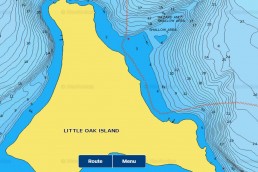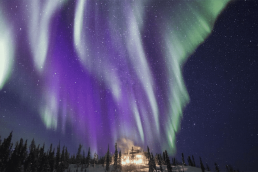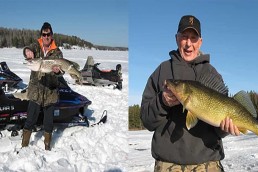If you haven’t experienced it you may want to add it to your list. It’s beautiful. It’s unique. It’s the northernmost point of the continental U.S. and is where the 14,552 islands of the lake begin: the Northwest Angle. This area in Lake of the Woods is home to only 110 residents and boasts the privilege of having the only one-room schoolhouse in Minnesota. In order to travel to the Angle, visitors must actually drive through Canada and enter back into the U.S.—unless you navigate via water in which you can remain in Minnesota.
About half of the dozen or so resorts in this area of the lake are on the mainland, a community called Angle Inlet. The others are located on islands throughout this scenic area. Each resort has its own style and culture, but the one thing they have in common is they all cater to anglers. For the past few years I’ve fished the NW Angle, in what I would call the early season, in May and June with family members. There is adventure around every corner, but we have started a tradition and the target is walleyes.
Nearly limitless areas to fish
Unlike much of the southern part of the lake, this area is full of structure. If you like points, reefs, sunken islands, flats, transition areas that include rocks, sand, mud or weeds, this area may be to your liking. Typically, in the early season a good starting point is near shore structure. Points coming off of the mainland or islands, neckdown areas with current, shallow areas around reeds where the water is warmer, or even shallow flats with some current, are all good starting points.
As far as depths go, it can vary this time of year. Not all walleyes are living the same pattern. What this means is you might catch some in 6 feet of water around a patch of reeds or on a flat and be fishing a point in 22 feet nearby and have success as well.
Most anglers anchor up in a key spot or use their trolling motor to skillfully work an edge. Electronics are definitely helpful. GPS with a good chip as well will bring to life hundreds of good walleye spots as well as being help in your navigation. Sonar is helpful too in pinpointing what areas are holding the fish.
Techniques
Jigging is key, and the go-to technique now is a jig and a minnow. The walleyes on Lake of the Woods don’t seem to mind a larger jig. A bigger jig head can be effective to bang the bottom and call the walleyes in, emulating prey. On other days, they prefer a slower drop of a lighter jig. Mix it up until you dial them in.
With the water in Lake of the Woods being “stained,” meaning it has a light coffee color tint to it from tannins in the water, some go-to colors to start with are gold, bubble gum, glow, orange and chartreuse or a combination thereof. Both live minnows and frozen emerald shiners work well on a jig in these waters. Some anglers will also use plastics. However, I’d have at least one person using live bait. Some days, baits can simply outfish plastics.
There are a couple of ways to hook a minnow when jigging. Traditionally, you can hook the minnow through the bottom lip up through the top lip with the jig. If you start missing fish, they aren’t getting the hook in their mouths. Place the hook through the mouth and out of the gills of the minnow. Push the minnow as far forward on the jig as possible and push the hook through the mid-section of the minnow’s body. This helps to hook the walleyes that are light-biters. It seems anglers don’t like the minnow a little bit crooked on a jig but the fish don’t seem to mind this and your hooking percentage can still rise.
Another good option if the walleyes are light-biters is using a stinger hook that connects to the jig. This allows a very small treble hook to be inserted near the tail of the minnow. A very small stinger hook can catch the big walleyes.
Crankbaits
The longer I fish, the less I believe old sayings about walleye fishing. One of those has to do with “not pulling crankbaits when the water is too cold.”
On a recent early-season trip to the NW Angle, I took some time to experiment. It was May and the ice had just gone out a few weeks prior. I took a few hours and pulled shallow-diving crankbaits through a flat area with some current rolling through it. I was in Flag Island flats, an area known to have many fish in May and early June. I was fishing with two friends and explained we may not catch a fish. But we were about to try something I had always wanted to—trolling shallow-diving shad-style baits in depths of 4-7 feet. We did end up whacking limits of walleyes, including a nice 28-incher. There are times when pulling crankbaits can be extremely effective in catching early-season ‘eyes.
As in many trolling situations, use different shapes, colors and wobbles of crankbaits until you home in on what the walleyes want that given day. After some time, an effective pattern will typically become evident. Typically in cold water, trolling speeds will be fairly slow, ranging from 1.7 to 2.2 mph. You should notice that some crankbaits will do better than others at slower speeds.
Walleyes rule in these parts, but get ready for a multi-species adventure when fishing the Angle. Saugers, pike, perch, crappies, smallmouths and even muskies on occasion, will all make guest appearances. You never know what you will catch on Lake of the Woods.
With such good early-season fishing on the south end of the lake with the walleye and sturgeon action on the Rainy River, and walleyes and pike along the south shore of Big Traverse Bay, the NW Angle tends to be overlooked or forgotten this time of year. Once you experience this area in the early season, there will be no more forgetting.
MWO
SHARE THIS POST
Did you enjoy this post?
You can be among the first to get the latest info on where to go, what to use and how to use it!
Joe Henry
Tournament angler and licensed charter captain Joe Henry fishes and hunts the Midwest. Henry is a media member of AGLOW and writes for numerous publications, creates videos, appears on a variety of outdoor TV and radio shows and is a frequent seminar speaker. Henry is the Executive Director of Lake of the Woods Tourism.



